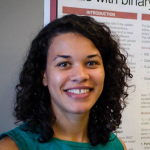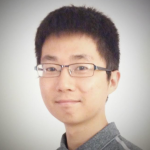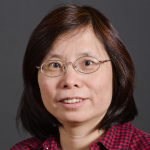People News for February
Arni S.R. Srinivasa Rao
In collaboration with Fiona Tomley and Damer Blake at The Royal Veterinary College at the University of London, Arni S.R. Srinivasa Rao, associate professor in the department of biostatistics and epidemiology at Augusta University, developed a grid model that shows the paths chickens take to find food and water. The walking patterns could give a clue to distinguish between sick and healthy chickens and help farmers reduce their losses in poultry farming.
The study, which was published in the journal Mathematical Methods in the Applied Sciences, has garnered wide media attention, including a story in the magazine Mental Floss and on the website statisticsviews.com.
On several occasions during past 5-6 years, Rao visited his two co-authors at their parasitology labs in London to understand the eimeria parasite spread in chickens and to conduct this collaborative study.
Other than at the Indian Statistical Institute and Augusta University, Rao has conducted his research in mathematical biology at Hiroshima University, the Indian Institute of Science, Benguluru, and University of Oxford.
Rao has published his modeling research in leading mathematical biology and mathematics journals, and he was one of the organizers and a scientific board member of the annual meetings of the Society of Mathematical Biology in 2015.
Brittney Bailey, Peng Liu, Joy Liu
Brittney Bailey, winner of the Lester R. Curtin award; Peng Liu, winner of the Lingzi Lu award; and Joy Liu, winner of the Bartko scholarship, will receive registration and travel support to the ASA Conference on Statistical Practice.
Lester R Curtin Award Winner Brittney Bailey is a PhD student in biostatistics at The Ohio State University. In 2012, she earned an MS in statistics from The Ohio State University, and in 2010, she earned a BA in mathematics from Messiah College. In her advanced longitudinal data course, she submitted the best paper in the class of eight doctoral students. Bailey was an outstanding teaching assistant at The Ohio State University, demonstrating great aptitude for understanding the potential sources of confusion for students and misconceptions about introductory statistics. She is currently a graduate student research assistant. In her first major assignment, she worked on meta-analysis of two recently completed clinical trials; a paper from this work is under review at Molecular Nutrition and Food Research. Her ultimate goal is to become a faculty member in biostatistics at an institution where teaching and research are equally encouraged and supported.
Lingzi Liu Memorial Award Winner Peng Liu is a second-year master’s student in biostatistics at the University of Pittsburgh. Prior to coming to the United States, he earned a bachelor’s degree in preventative medicine in Sun Yat-sen University and worked at the FDA in Guangzhou, China. Peng is an outstanding student, earning top scores in his courses and the highest GPA of all second-year students in the biostatistics department. He was recently selected for a student researcher position in the department of renal in the University of Pittsburgh School of Medicine. Peng hopes to use his skills and knowledge in biomedical research to improve health care.
John Bartko Award Winner Joy Liu is a recent graduate of Cornell University and ASA-accredited GStat. She is currently employed as a statistician at the Energy Information Administration. In 2013, she earned both her Certified Base and Advanced Programmer for SAS 9 from the SAS Institute. Liu will take advantage of the networking and mentoring opportunities available at CSP to guide her toward her career goal of becoming an Accredited Professional Statistician. She looks forward to using her expertise and statistical training to sharpen her analytical and communication skills so she can write accurate and relevant articles for the Energy Information website.
First U.S. Team Wins Data Mining Cup
In 2014, a team of Iowa State University graduate students topped 98 other universities from 28 countries to capture first place in the 15th annual Data Mining Cup (DMC). It is the first time a team from the United States has won the competition.
Teams had six weeks to develop a solution for a data mining problem about optimal return prognosis. They used an unidentified online store’s historical purchase data to create a model for new orders that predicted the probability of a purchase being returned.
Iowa State team members and their departments are Guillermo Basulto-Elias (statistics), Fan Cao (statistics), Xiaoyue Cheng (statistics), Marius Dragomiroiu (computer science), Jessica Hicks (bioinformatics and computational biology), Cory Lanker (statistics), Ian Mouzon (statistics), Lanfeng Pan (statistics), and Xin Yin (bioinformatics and computational biology/statistics). Lanker and Mouzon were on the 2013 Iowa State team, which finished in fifth place.
To read about the Iowa State team, visit the university website.
The 2016 competition begins April 6. Teams can begin registering March 9. Visit the DMC website for more information.
John M. Abowd
Cornell University professor John M. Abowd will join the U.S. Census Bureau as the new associate director for research and methodology and chief scientist through an interagency personnel agreement. The appointment will be effective June 1.
“I’m thrilled to have Dr. Abowd coming on board to help lead critical work to modernize the Census Bureau’s operations and products,” Census Director John Thompson said. “John is an internationally renowned scholar and a great addition to lead our research and methodology efforts. His research on privacy and statistical disclosure limitation are particularly relevant as we work to improve the utility of our data products to our users and honor our commitment to maintain the confidentiality of the data American people and businesses provide us.”
Abowd joined the faculty of the Cornell University School of Industrial and Labor Relations in 1987. He is currently the Edmund Ezra Day Professor of Economics, Statistics, and Information Science. He began his long association with the Census Bureau in 1998, when he joined the team of distinguished senior research fellows who helped found the Longitudinal Employer-Household Dynamics program. He has served continuously since 1998 as a scientific adviser to that program and others at the bureau. Since 2011, Abowd has been the principal investigator for the Cornell University node of the National Science Foundation-Census Research Network and co-principal investigator of its coordinating office.
Abowd is a fellow and past president of the Society of Labor Economists. He is also a fellow of the American Statistical Association and the Econometric Society, as well as an elected member of the International Statistical Institute. He serves on the National Research Council’s Committee on National Statistics and the American Economic Association’s Committee on Economic Statistics.
Larry Lesser
Larry Lesser’s parody “The Gambler” was judged one of the winning songs in the fall 2015 math song contest conducted by the National Museum of Mathematics.
“The Gambler,” already named the “Best Online Submission” in the ASA’s JSM 2014 Got Talent competition, is part of Larry’s broader effort to educate about lotteries and use music as a way to motivate mathematics/statistics.
Winning writers performed to a full house at the museum. View footage of Lesser’s performance here.
Sastry G. Pantula and Jessica Utts
Sastry G. Pantula, 2010 ASA president, and Jessica Utts, current ASA president, were guest speakers at the Second International Conference on the Theory and Application of Statistics, which took place in the department of statistics at the University of Dhaka in Bangladesh December 27–29, 2015.
The conference brought statisticians together from around the world to explore new frontiers of statistical theory and applications in teaching, research, and the use of statistics in government and nongovernment policymaking, with a focus on developing countries such as Bangladesh.
Kicking off the three-day conference was president of the Dhaka University Statistics Department Alumni Association, Kazi Saleh Ahmed. He called for upgrading the quality of statistics and statistical analysis to ensure transparency, accountability, credibility, and morality. He called for statisticians to work together to fulfill the dream of making Bangladesh a country free from poverty, hunger, malnutrition, illiteracy, and fundamentalism.
Read more about the event at dusdaa.org and in The Financial Express.
Simon Singh

Photo credit Nick Smith. Simon Singh is receiving the 2016 Joint Policy Board for Mathematics Communications Award for Expository and Popular Books.
Simon Singh, a science writer and broadcaster, is receiving the 2016 Joint Policy Board for Mathematics (JPBM) Communications Award for Expository and Popular Books.
Although Singh is not a mathematician—his doctorate is in particle physics—he has a deep love for and fascination with mathematics that shines through his many books and productions. One of his first was the documentary “The Proof.” Broadcast in the PBS Nova series, it brought to life the story of Andrew Wiles’s proof of Fermat’s Last Theorem. Singh’s 1997 book on the same subject, Fermat’s Enigma in North America and Fermat’s Last Theorem in the UK, was a number-one bestseller in Britain and has been translated into more than 25 languages.
Singh’s other books include The Code Book (1999), a history of codes and codebreaking, and The Simpsons and Their Mathematical Secrets (2013), which is about the numerous references to mathematics hidden in the world’s most successful TV show. His radio and TV programs in the United Kingdom include “The Science of Secrecy” (a five-part history of cryptography), “Five Numbers,” “Another Five Numbers,” and “A Further Five Numbers.” He also has participated in numerous stage productions that involved mathematics. His school-based projects include the Undergraduate Ambassadors Scheme, which currently runs in more than 100 STEM departments in the UK, sending 1,000 undergraduates into schools each year to support students.
The JPBM represents the American Mathematical Society (AMS), American Statistical Association, Mathematical Association of America, and Society for Industrial and Applied Mathematics.
Read more about Singh on the AMS website.




















